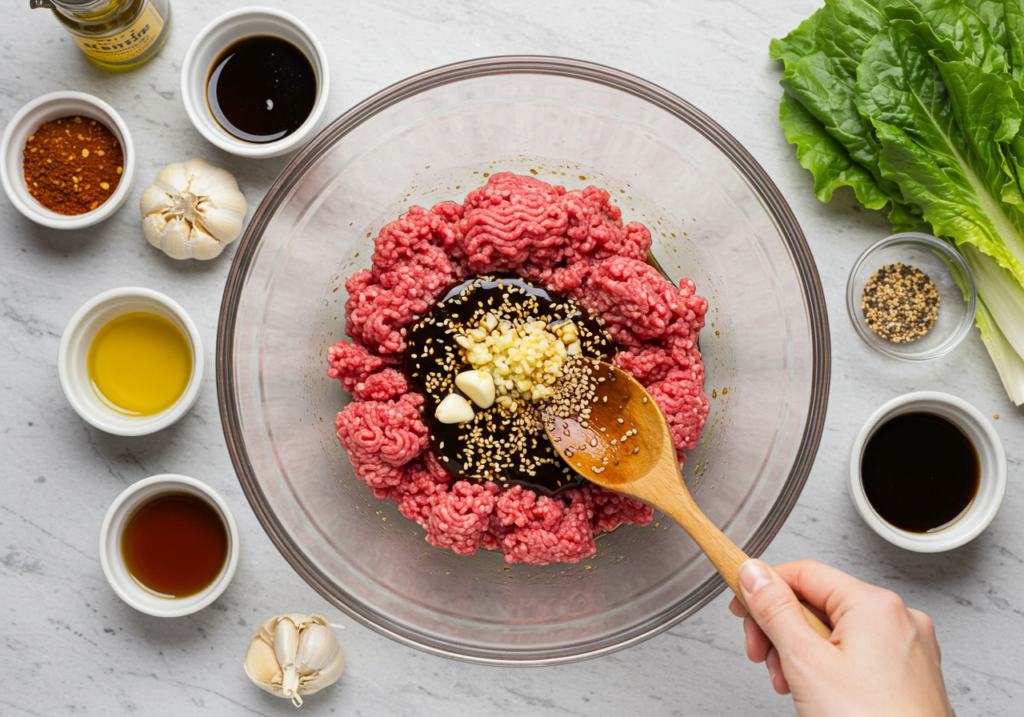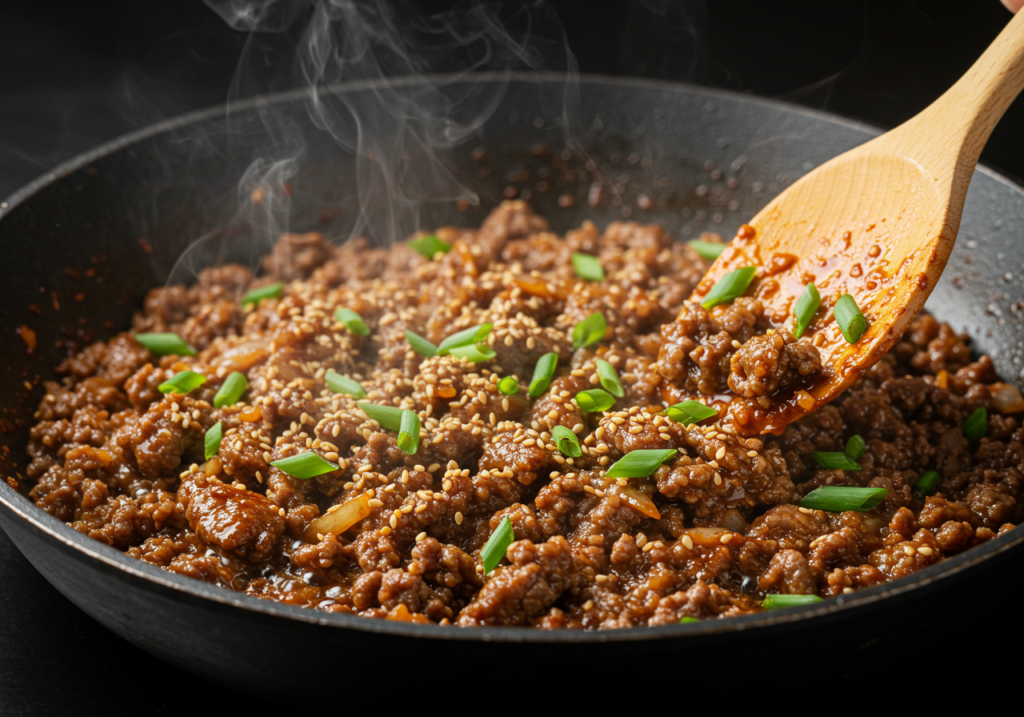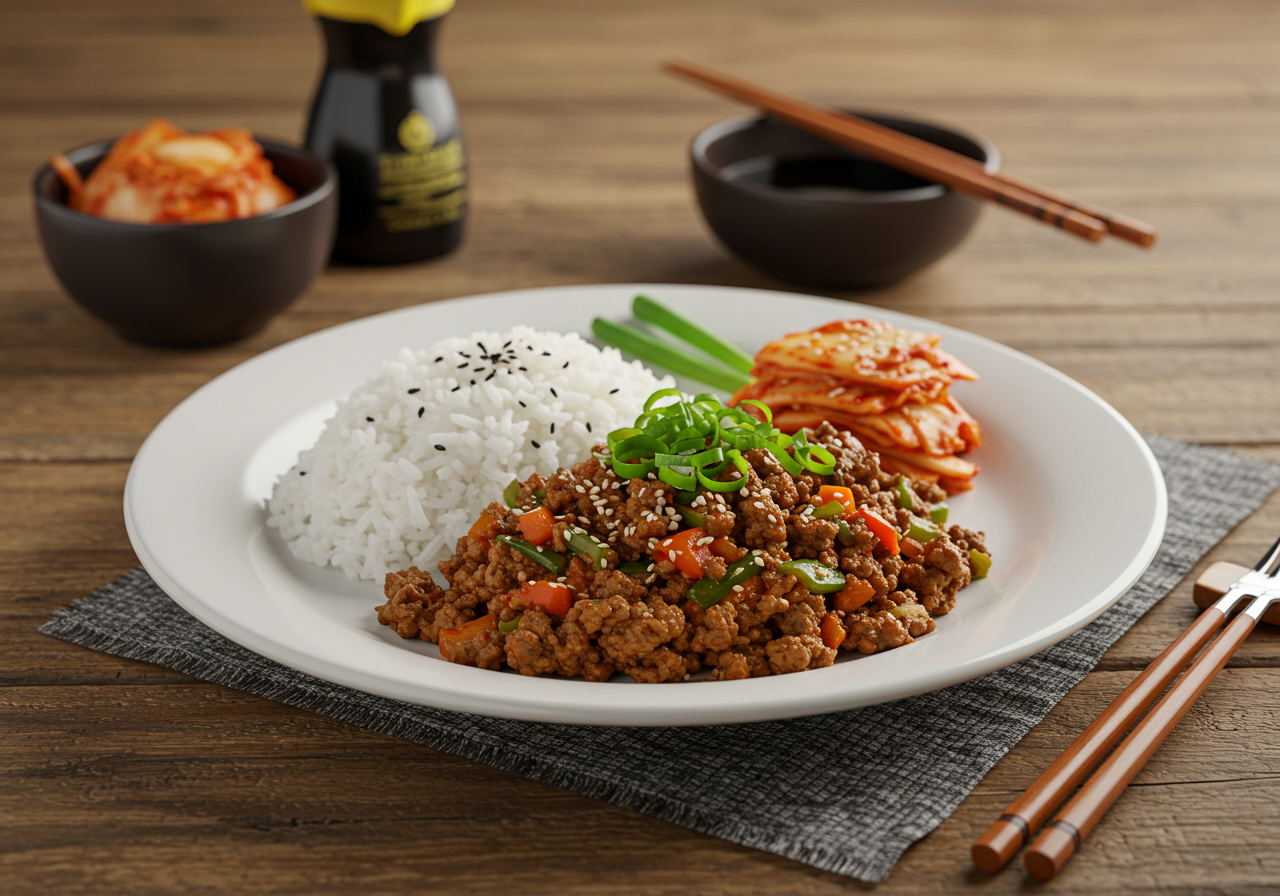Korean cuisine has captivated food lovers worldwide, and one dish that stands out is bulgogi. Known for its sweet, savory, and umami-rich flavors, bulgogi traditionally features thinly sliced beef. However, the ground beef variation offers an easy, budget-friendly twist without sacrificing taste. This article explores everything you need to know about Korean ground beef bulgogi, from its origins and recipe steps to serving suggestions and nutritional benefits. Let’s dive in!
Table of contents
- Introduction to Korean Ground Beef Bulgogi
- Key Ingredients for Authentic Ground Beef Bulgogi
- Step-by-Step Recipe for Making Korean Ground Beef Bulgogi
- Serving Suggestions and Pairings
- Health Benefits and Nutritional Value of Bulgogi
- Popular Variations of Korean Bulgogi
- Tips and Tricks for Perfect Ground Beef Bulgogi
- FAQs About Korean Ground Beef Bulgogi
- How to Store and Reheat Leftover Ground Beef Bulgogi
- Cultural Significance of Bulgogi in Korean Cuisine
Introduction to Korean Ground Beef Bulgogi
What is Korean Ground Beef Bulgogi?
Korean ground beef bulgogi is a modern spin on the traditional bulgogi, which translates to “fire meat” in Korean. Instead of using thinly sliced beef, this version utilizes ground beef, making it quicker to prepare and more accessible for everyday cooking. The dish features the same iconic marinade a mouthwatering blend of soy sauce, sesame oil, garlic, ginger, and sugar that creates its signature balance of sweet and savory flavors.
This ground beef adaptation is a perfect introduction to Korean cuisine for beginners. It pairs wonderfully with a bowl of steamed rice or lettuce wraps, making it a versatile option for both weeknight dinners and meal prep.
The History and Origin of Bulgogi
Bulgogi has roots dating back over a thousand years to Korea’s Goguryeo dynasty. Traditionally cooked over an open flame, it was a dish reserved for royalty due to its use of premium ingredients like beef and spices. Over time, bulgogi has evolved and become a staple in Korean households, often enjoyed during celebrations or as part of a hearty family meal. The ground beef version reflects the adaptability of this beloved dish in modern cooking.
Why Ground Beef is a Popular Variation?
Ground beef bulgogi has gained popularity for its affordability, convenience, and versatility. Unlike thinly sliced beef, which may require a trip to a specialty store, ground beef is readily available and cooks much faster. In addition, it absorbs the marinade more thoroughly, ensuring every bite is bursting with flavor. Plus, this version is easier to incorporate into non-traditional dishes like tacos, pasta, or even burgers, giving it a global appeal.
Key Ingredients for Authentic Ground Beef Bulgogi
Essential Ingredients for Flavorful Bulgogi
To create authentic Korean ground beef bulgogi, the marinade is the star of the show. A perfect blend of soy sauce, sesame oil, garlic, ginger, and sugar forms the foundation of its sweet-savory flavor. Thinly sliced green onions and toasted sesame seeds enhance the aroma and add a layer of crunch. In addition, incorporating freshly ground black pepper or a hint of gochugaru (Korean red pepper flakes) can elevate the flavor profile with a subtle heat.
The ground beef itself should have a good fat content—about 80% lean and 20% fat—to ensure a juicy, flavorful dish. Using high-quality meat will make a noticeable difference in taste and texture.
Substitutions for Hard-to-Find Ingredients
If you’re missing a few traditional ingredients, don’t worry! Soy sauce can be replaced with tamari for a gluten-free option, while honey or maple syrup can work as a sugar substitute for a natural sweetness. If sesame oil is unavailable, olive oil with a dash of toasted sesame seeds can mimic the nutty flavor.
For those who can’t find gochugaru, paprika or crushed red pepper flakes are great alternatives. Fresh garlic and ginger can also be swapped with their powdered counterparts, although the fresh versions are always preferred for the best flavor.
For additional recipes with complementary flavors, you can check out ideas like jalapeno chicken recipes that pair well with Korean-inspired dishes. Their balance of spice and sweetness complements the bulgogi marinade beautifully.
Step-by-Step Recipe for Making Korean Ground Beef Bulgogi
Preparation: What You Need to Get Started

Before diving in, gather all your ingredients. You’ll need ground beef, soy sauce, sesame oil, sugar, garlic, ginger, green onions, and sesame seeds. It’s also helpful to have a mixing bowl for marinating and a large skillet for cooking. This dish comes together quickly, so having everything prepped in advance is essential.
Marinating the Ground Beef for Maximum Flavor
The secret to delicious Korean ground beef bulgogi lies in the marinade. Combine soy sauce, sesame oil, sugar, minced garlic, grated ginger, and chopped green onions in a bowl. Toss in the ground beef and mix well until every bit is coated. Let it marinate for at least 30 minutes though overnight is ideal for deeper flavor. The marinade not only tenderizes the beef but also infuses it with rich, umami goodness.
Cooking Techniques: Stir-Fry vs Grilling

Stir-frying is the quickest and most common method for preparing ground beef bulgogi. Heat a skillet over medium-high heat, add a drizzle of sesame oil, and cook the beef mixture, breaking it into small pieces as it browns. However, if you’re looking for a smoky, char-grilled flavor, try grilling small beef patties or kebabs made from the marinated mixture.
Tips for Perfect Ground Beef Texture
To prevent the beef from becoming too dry, cook it just until the pink disappears. Stir frequently to ensure even cooking, and avoid overcrowding the pan. A dash of water or additional marinade can be added during cooking if the beef looks too dry.
Serving Suggestions and Pairings
What to Serve with Korean Ground Beef Bulgogi
Ground beef bulgogi is versatile and pairs well with numerous sides. The classic choice is steamed white or brown rice, which soaks up the flavorful juices of the dish. For a low-carb option, serve it with lettuce wraps or over a bed of cauliflower rice.
Rice and Side Dishes: Kimchi, Japchae, and More
Traditional Korean sides, or banchan, take this dish to the next level. Kimchi adds a tangy kick, while japchae (stir-fried glass noodles) offers a delightful textural contrast. Other great options include pickled radish, spicy cucumber salad, or even a dollop of gochujang (Korean chili paste) for extra heat.
For unique side ideas, explore spaghetti pizza recipes for a fusion take, or consider naan pizza tips to pair with bulgogi-inspired flavors.
Health Benefits and Nutritional Value of Bulgogi
Is Korean Ground Beef Bulgogi Healthy?
Korean ground beef bulgogi can be a healthy meal option when prepared with the right balance of ingredients. The lean protein in ground beef provides essential amino acids, while the marinade’s soy sauce and garlic add antioxidants and promote overall health. Sesame oil, although rich in fats, is a source of healthy unsaturated fats and nutrients like vitamin E. However, it’s important to keep an eye on portion sizes due to the sugar and sodium content in the marinade.
Calorie Count and Macronutrient Breakdown
A single serving of ground beef bulgogi (about 1 cup) typically contains around 250-300 calories, depending on the fat content of the beef and the amount of marinade used. It offers a good balance of macronutrients—primarily protein with moderate amounts of carbohydrates and fats. For a lighter version, you can opt for ground turkey or chicken instead of beef, as they reduce both calories and fat content while maintaining flavor.
How to Make It Low-Carb or Keto-Friendly
To adapt Korean ground beef bulgogi to a low-carb or keto diet, simply swap the sugar in the marinade for a low-calorie sweetener like stevia or erythritol. Serve the bulgogi with cauliflower rice or zucchini noodles instead of traditional steamed rice. Adding extra vegetables like spinach, bell peppers, or mushrooms can further enhance the nutritional value without increasing carbs.
Note: For more delicious low-carb recipe ideas, explore roasted jalapeno chicken recipes for flavorful alternatives.
Popular Variations of Korean Bulgogi
Traditional Beef Bulgogi vs Ground Beef Bulgogi
Traditional beef bulgogi uses thinly sliced cuts like ribeye or sirloin, which are marinated and grilled over an open flame for a smoky, caramelized finish. Ground beef bulgogi, on the other hand, is simpler to prepare and has a slightly different texture. While it lacks the charred edges of the traditional version, the ground beef absorbs the marinade more thoroughly, resulting in a consistently flavorful bite.
Spicy Bulgogi: Adding a Kick with Gochujang
For those who love spicy food, adding gochujang (Korean chili paste) to the marinade can create a fiery variation of ground beef bulgogi. Simply mix a tablespoon or two of gochujang into the marinade for a tangy, spicy twist. Adjust the amount based on your spice tolerance. Alternatively, gochugaru (Korean red pepper flakes) can also be used for a milder heat.
Vegan and Vegetarian Bulgogi Options
For plant-based diets, tofu or tempeh can replace ground beef in bulgogi. Use the same marinade to ensure the rich, sweet-savory flavor is retained. Mushrooms, particularly shiitake or portobello, are another great option due to their meaty texture and ability to soak up the marinade. You can also try textured vegetable protein (TVP) as a high-protein substitute for ground beef.
Tips and Tricks for Perfect Ground Beef Bulgogi
Common Mistakes to Avoid
When preparing Korean ground beef bulgogi, avoid overcooking the beef. It’s easy to dry out the meat if it’s left on the heat for too long. Additionally, don’t skip the marination process—it’s crucial for infusing the beef with flavor. Another common mistake is using too much sugar in the marinade, which can overpower the other ingredients and result in an overly sweet dish.
How to Make Your Bulgogi Taste More Authentic
For a more authentic flavor, use traditional Korean ingredients like gochugaru, fresh ginger, and toasted sesame seeds. If possible, opt for Korean soy sauce, as its slightly sweeter profile enhances the dish. Cooking the beef in a cast-iron skillet or on a grill can also mimic the smoky, caramelized edges found in traditional bulgogi.
Using Pre-Made Marinades vs Homemade Marinades
While pre-made marinades save time, a homemade marinade allows you to control the balance of flavors and customize the sweetness or spiciness to your liking. It’s also free of preservatives and artificial ingredients commonly found in store-bought options. Therefore, whenever time permits, it’s worth making your own marinade for the best results.
Note: If you’re looking for other easy-to-make recipes with bold flavors, check out pickle pie pizza guides for a unique twist on traditional dishes.
FAQs About Korean Ground Beef Bulgogi
What is the difference between traditional and ground beef bulgogi?
Traditional bulgogi typically features thinly sliced cuts of beef, such as ribeye or sirloin, while Korean ground beef bulgogi uses ground beef. This variation is easier to prepare, cooks faster, and is often more budget-friendly. However, it still delivers the sweet and savory flavors that make bulgogi a favorite worldwide.
How long should I marinate the ground beef?
For the best flavor, marinate the ground beef for at least 30 minutes. If you have extra time, letting it sit overnight in the refrigerator will enhance the depth of flavor. However, be cautious not to marinate for too long, as the soy sauce in the marinade could overpower the beef’s natural taste.
Can I freeze Korean Ground Beef Bulgogi?
Yes, Korean ground beef bulgogi can be frozen! Store the cooked or raw marinated beef in an airtight container or freezer bag for up to three months. When reheating, thaw in the refrigerator overnight and cook as usual. Freezing the marinade with the beef helps retain its rich flavor.
What are some good substitutes for soy sauce in the marinade?
For a soy-free alternative, use coconut aminos, which mimics soy sauce’s savory profile while being gluten-free. Tamari is another excellent substitute, especially for those with gluten sensitivities.
How to Store and Reheat Leftover Ground Beef Bulgogi
Proper Storage Techniques to Keep It Fresh
To store leftover Korean ground beef bulgogi, transfer it to an airtight container and refrigerate within two hours of cooking. It will stay fresh in the fridge for up to three to four days. For longer storage, freeze the leftovers as mentioned above. Properly storing the dish ensures you retain its flavors and prevent spoilage.
Best Methods to Reheat Without Losing Flavor
Reheating ground beef bulgogi can be tricky, but using the right method helps maintain its tenderness. The stovetop is the best option—simply heat it in a skillet over low-medium heat with a splash of water or extra marinade to prevent it from drying out. Alternatively, you can microwave it in short intervals, stirring occasionally to ensure even heating. However, avoid high heat to keep the meat juicy and flavorful.
Cultural Significance of Bulgogi in Korean Cuisine
How Bulgogi Reflects Korean Culinary Traditions
Bulgogi holds a special place in Korean cuisine. It embodies the country’s emphasis on harmonious flavors and the communal aspect of dining. Traditionally prepared for festive occasions and family gatherings, bulgogi showcases Korea’s love for blending sweet, savory, and umami elements in a single dish. Korean ground beef bulgogi is a modern adaptation that maintains these values while making the dish accessible to more people worldwide.
Bulgogi in Modern Korean Pop Culture
In recent years, bulgogi has gained global popularity, often featured in Korean dramas, food vlogs, and even fusion recipes. The ground beef version has also found its way into creative dishes like bulgogi tacos and bulgogi sliders, which appeal to international audiences. This evolution of bulgogi demonstrates the adaptability of Korean cuisine while preserving its authentic flavors.

